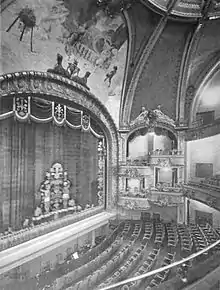Empire Theatre (42nd Street)
The Empire Theatre is the former Eltinge Broadway theatre located on West 42nd Street in Manhattan, New York City. It serves as the entrance to a multiplex movie theater.
.jpg.webp)

History
Opened in 1912, the Eltinge 42nd Street Theatre,[1] was designed by noted theatre architect Thomas W. Lamb[1] for the Hungarian-born impresario A. H. Woods.[2] It was named for Woods' star, Julian Eltinge, an American stage and film actor who gained fame as a female impersonator.[1][3] However, Eltinge himself never performed there.[4] The theater's 900 seats were uniquely apportioned in "slender," "medium," and "stout" widths for patrons of all sizes. Woods moved his executive offices from the Putnam Building to the entire upper floor in August 1912.[5]
Its first production, on September 11, 1912, was Bayard Veiller's Within the Law, a hit that ran for more than a year.[6] Woods co-owned the play and its rights with Lee Shubert. Over the course of two decades the theater hosted 50 productions. Both Laurence Olivier and Clark Gable appeared in plays at the Eltinge just before signing with Hollywood studios. Olivier appeared in "Murder on the Second Floor" in 1929, and Gable was in Love Honor and Betray in 1930.
Woods lost the theater during the Great Depression, and in 1931 it became the second burlesque house to open on 42nd Street, following Minsky's Republic Theater (now the New Victory). After burlesque was outlawed in New York, in 1942 the theater was renamed the "Laff Movie" and ran comedy films. [1] Late in 1954, while still showing second-run films, it was renamed the Empire Theatre [1] after the demolition of the original, beloved previous theatre of the same name.
From the late 1950s until the late 1980s, 42nd Street decayed into an unsavory mix of arcades, grindhouse and porno theaters, and peep shows, although the Empire never showed porno films. In the mid-1980s, state officials and then-Mayor Ed Koch used eminent domain to condemn and take control of decrepit buildings and close down the theaters while a redevelopment plan was devised. In 1990, the New 42nd Street coalition was formed to oversee the redevelopment of seven neglected and historic theatres on 42nd Street, including the Eltinge/Empire. As that plan was proceeding, in 1993, the exterior of the Empire was used as the Pandora Theater for the film Last Action Hero. (The Orpheum Theater in Los Angeles was used for interiors.)
In 1998, as part of the renewal of 42nd Street, real estate developer Bruce Ratner had the Empire lifted off its foundation and moved westward approximately 170 feet (52 m)[3] to serve as the entrance to a multiplex. (The Empire could not be demolished because its terra-cotta facade and interior had been named landmarks.[7]) Two large balloons representing Abbott and Costello, who first performed together in burlesque at the theater in 1935, were rigged to appear as if they were dragging the theater westward. Jackie Gleason also appeared in burlesque shows at the Eltinge in the late 1930s.
In its new location directly opposite Loews' E-Walk movie theatre (now owned by Regal Cinemas), the shell of the theatre auditorium was converted into a lobby and lounge for a 25-screen AMC Theatres multiplex, the AMC Empire 25, AMC's first theatre in New York City.[8] Escalators pass through the former proscenium arch of the stage to the newly built auditoriums above. The theater opened in April 2000 at an estimated cost of $70 million, making it one of the most expensive movie theatres ever built. In its first year, it did not screen many major films but in its second year it became one of the most popular in the world, grossing over $500,000 a week.[3][9][10]
References
Notes
Citations
- "Empire Theatre-ibdb:The Internet Broadway Database". ibdb.com. The Broadway League. Retrieved June 24, 2013.
- "That Eltinge Elevator" (PDF). Variety. XXVI (10): 11c. 11 May 1912.
- John Holusha (February 28, 1998). "The Theater's on a Roll, Gliding Down 42d Street; Fast-Moving Times Square Revitalization Leaves No Stone or Building Unturned". The New York Times. Retrieved June 24, 2013.
- Frank Cullen, Frank; Hackman, Florence; McNeilly, Donald (2007). "Julian Eltinge". Vaudeville old & new: an encyclopedia of variety performances in America, Volume 1. Psychology Press. pp. 353–4. ISBN 978-0-415-93853-2. ISBN 9780415938532
- "Woods New Quarters" (PDF). Variety. 28 (11): 11 [89]. 15 August 1912. Retrieved 5 October 2021.
- Henderson, Mary C. & Greene, Alexis (2008). The Story of 42nd Street: The Theaters, Shows, Characters, and Scandals of the World's Most Notorious Street. Back Stage Books. pp. 147–148. ISBN 978-0-8230-3072-9.
- Taking the Show Out on the Road: Breslin, Jimmy. Newsday. 01 Mar 1998: A04.)
- "Regal E-Walk Stadium 13 & RPX". cinematreasures.org. Retrieved April 27, 2021.
- "AMC Empire 25". cinematreasures.org. Retrieved June 24, 2013.
- Hayes, Dade (August 20, 2001). "Gotham plex riding high". Variety. p. 6.